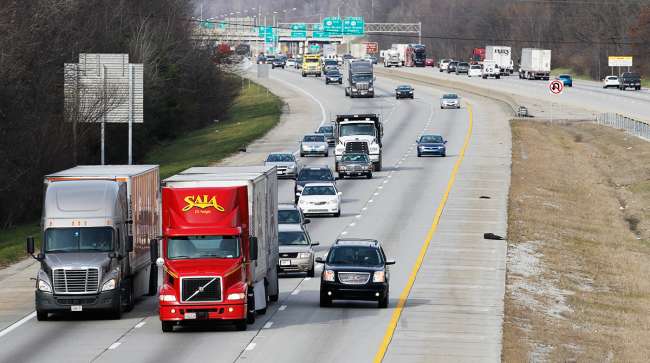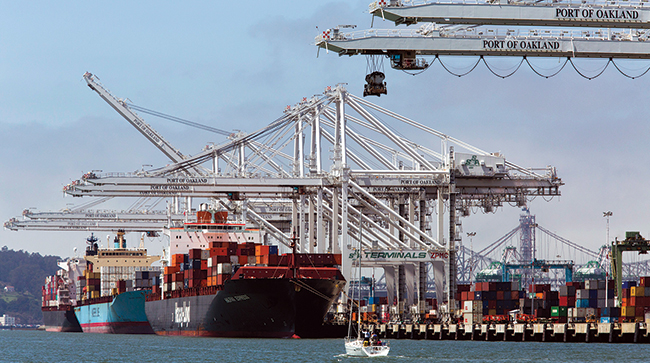Senior Reporter
Truck Tonnage Surges 9.5% in October

Truck tonnage surged in October after a brief lull in September as shippers stockpiled goods ahead of possible tariffs on imports from China, according to data released by American Trucking Associations on Nov. 20.
ATA’s seasonally adjusted for-hire truck tonnage index is 9.5% higher than in October a year ago. Sequentially, the index jumped 6.3% to 119.9 in October from a revised 112.8 in September.
“Last month’s strength was due, at least in part, to strong import numbers, especially on the West Coast,” ATA Chief Economist Bob Costello said. “This is likely a pull ahead of imports as shippers try to take delivery of goods before Jan. 1, when tariffs on a large list of goods from China increase from 10% to 25%.”

Costello
ATA calculates the tonnage index based on surveys of member carriers. It is a closely followed barometer of freight-hauling demand.
“There are two rational explanations for why freight is strong; one is the strong economy, and two, there is a possible distortion because of the expectation of tariffs that people have been talking about,” Transport Futures economist Noel Perry told Transport Topics.
However, Perry said the 9.5% monthly increase is larger than expected and could be an anomaly.
“It is well within the normal range of variation of the ATA numbers,” he said. “It takes three data points to establish a trend and this is one, in an inherently volatile metric.”

Perry
Still, Perry said things are looking good as 2018 finishes and 2019 nears.
“The economy is stronger than people expected it to be half a year ago, stronger than I expected,” he added.
Economist Rajeev Dhawan, director of the Economic Forecasting Center at Georgia State University, told TT, “People have jobs, people have incomes, people have taken money from refinancing their houses, gasoline prices are falling, so the consumer is going to spend — and that means the economic activity will reflect that.”
But, Dhawan is cautious looking at the economy in 2019 — for businesses, including trucking, and consumer spending.
“I get the feeling the business cycle has peaked … that is because of the turmoil in the stock market, the tariff issue, so many other things going on. The confidence of the large corporations took a nosedive in the third quarter. The small-business optimism is still hanging in there. I see a problem over there, six to nine months from now, but not right now.”

Dhawan
Dhawan sees slower, steady growth in the trucking industry and across the U.S. economy with the gross domestic product increasing in the 2-2.5% range next year. He is not forecasting a recession unless three things happen simultaneously: First, the Federal Reserve raises interest rates too fast; second, trade negotiations with China falter; and third, the United Kingdom’s departure from the European Union fails badly.
ATA’s truck tonnage report comes just days after many of the nation’s largest ports reported September and October were record months. Shippers are anticipating a big holiday shopping season, and goods were being rushed into the United States ahead of tariffs against several nations, including China.
The Port of Los Angeles processed a record 952,500 industry-standard 20-foot-equivalent units, or TEUs, in October. That marked a 27.2% increase from nearly 748,800 in the same month in 2017. October also was the busiest month in the port’s 111-year history.
The port estimates that the U.S. tariffs on Chinese goods as well as retaliatory duties could impact 15% of the shipments that flow through the facility.
Along with several other ports, the Port of Oakland said Nov. 16 it had its busiest peak season ever for imports during the past three months. The port said it handled the equivalent of 250,686 TEUs from August through October, the traditional highwater mark for container shipping. That broke the peak season import record of 233,825 containers set in the summer and fall of 2017.

Containerships at the Port of Oakland. (Ken James/Bloomberg News)
The latest ACT Research For-Hire Trucking Index also shows tightness is returning to trucking. The report showed the supply-demand balance increasing to 55.6% on a seasonally adjusted basis in October from 50.1 in September.
“We saw good sequential improvement in October freight volume and truck utilization, which we expect to continue through the holiday season. But, we’ll have to be careful of the effects of pre-tariff shipping for the next several months,” ACT Research Vice President and Senior Analyst Tim Denoyer said. “This corresponds to the 18% year-over-year increase in container imports at the ports of Los Angeles and Long Beach in October, so it’s fair to say the pre-ship is helping and will likely reverse to temporarily loosen supply-demand in early 2019.”
Staff Writer Daniel P. Bearth contributed to this report.




